Why is my Scheppach Saw motor making excessive noise?
- KKathryn LeeSep 10, 2025
If your Scheppach Saw motor is making excessive noise, it could be due to damaged coils or a defective motor. Arrange for a specialist to inspect the motor.




Why is my Scheppach Saw motor making excessive noise?
If your Scheppach Saw motor is making excessive noise, it could be due to damaged coils or a defective motor. Arrange for a specialist to inspect the motor.
Why is the saw cut rough or wavy with my Scheppach Saw?
If the saw cut is rough or wavy when using your Scheppach Saw, it may be due to a dull saw blade or a tooth shape that isn't appropriate for the material thickness. To resolve this, try re-sharpening the saw blade or using a more suitable blade.
What to do if the Scheppach HM216 Saw motor does not reach its full power?
If the motor of your Scheppach Saw does not reach its full power, it might be because the circuits in the network are overloaded. Avoid using other equipment or motors on the same circuit.
What to do if Scheppach HM216 motor starts up slowly?
If the Scheppach Saw motor starts up slowly and does not reach operating speed, the voltage may be too low, the coils may be damaged, or the capacitor may be burnt. Contact the utility provider to check the voltage. Arrange for a specialist to inspect the motor and replace the capacitor.
Why Scheppach Saw motor makes excessive noise?
If the Scheppach Saw motor makes excessive noise, it may be due to damaged coils or a defective motor. Arrange for a specialist to inspect the motor.
How to fix Scheppach HM216 when the motor does not work?
If the motor of your Scheppach Saw does not work, it could be due to a defective motor, cable, or plug, or burnt fuses. Arrange for a specialist to inspect the machine. Check the fuses and replace them if necessary.
Why does my Scheppach Saw motor make excessive noise?
If your Scheppach Saw motor makes excessive noise, it could be due to damaged coils or a defective motor. Arrange for a specialist to inspect the motor.
Why is my Scheppach HM216 cut rough or wavy?
A rough or wavy cut from your Scheppach Saw is likely due to a dull saw blade or a tooth shape that isn't appropriate for the material thickness. Re-sharpen the saw blade, or use a more suitable blade for the material you're cutting.
Why does the Scheppach HM216 motor start up slowly?
If your Scheppach Saw motor starts slowly and doesn't reach operating speed, the voltage may be too low, the coils may be damaged, or the capacitor may be burnt. Contact the utility provider to check the voltage. Have a specialist inspect the motor. Have a specialist replace the capacitor.
How to fix a rough or wavy cut with my Scheppach Saw?
If your Scheppach Saw is producing rough or wavy cuts, the saw blade may be dull, or the tooth shape might not be appropriate for the material thickness. Try re-sharpening the saw blade, or using a more suitable blade.
Visual indicators and their operational significance.
Details about the manufacturer and the purpose of the manual.
Listing and identifying parts of the machine based on figures.
What's included and the machine's designed purpose.
Essential safety practices for all power tools.
Guidelines for a safe work area and operator protection.
Safety rules related to electrical connections and usage.
Proper handling, maintenance, and care of the power tool.
Specific safety rules for mitre saws and maintenance aspects.
Understanding remaining hazards and protective measures.
Guidelines for selecting, using, and maintaining saw blades.
Information on the laser's function and safety.
Key technical data of the machine including power and dimensions.
Details on sound pressure and power levels, and required protection.
Unpacking, checking delivery, and initial setup steps.
Instructions on how to securely mount the saw.
How to attach and secure parts like clamping devices.
Adjusting stops and guards for precise 90-degree cuts.
Step-by-step guide for executing 90° crosscuts.
How to set up and execute crosscuts with turntable angles.
Adjusting the head for mitre cuts and setting stops.
Performing cuts with both angled head and turntable.
Setting the maximum depth of cut for specific tasks.
Connecting dust extractors and using the sawdust bag.
Detailed procedure for replacing the saw blade safely.
Operating and calibrating the laser for precise cutting lines.
Steps for safely moving the machine.
General care, cleaning guards, and replacing table inserts.
Guidelines for storing the tool to ensure longevity.
Compliance with standards for power supply and extension cords.
Proper procedures for environmentally friendly disposal.
Identifying common issues and their solutions.
Visual indicators and their operational significance.
Details about the manufacturer and the purpose of the manual.
Listing and identifying parts of the machine based on figures.
What's included and the machine's designed purpose.
Essential safety practices for all power tools.
Guidelines for a safe work area and operator protection.
Safety rules related to electrical connections and usage.
Proper handling, maintenance, and care of the power tool.
Specific safety rules for mitre saws and maintenance aspects.
Understanding remaining hazards and protective measures.
Guidelines for selecting, using, and maintaining saw blades.
Information on the laser's function and safety.
Key technical data of the machine including power and dimensions.
Details on sound pressure and power levels, and required protection.
Unpacking, checking delivery, and initial setup steps.
Instructions on how to securely mount the saw.
How to attach and secure parts like clamping devices.
Adjusting stops and guards for precise 90-degree cuts.
Step-by-step guide for executing 90° crosscuts.
How to set up and execute crosscuts with turntable angles.
Adjusting the head for mitre cuts and setting stops.
Performing cuts with both angled head and turntable.
Setting the maximum depth of cut for specific tasks.
Connecting dust extractors and using the sawdust bag.
Detailed procedure for replacing the saw blade safely.
Operating and calibrating the laser for precise cutting lines.
Steps for safely moving the machine.
General care, cleaning guards, and replacing table inserts.
Guidelines for storing the tool to ensure longevity.
Compliance with standards for power supply and extension cords.
Proper procedures for environmentally friendly disposal.
Identifying common issues and their solutions.
| Motor Power | 2000 W |
|---|---|
| Blade Diameter | 216 mm |
| Blade Bore | 30 mm |
| No-load Speed | 5000 rpm |
| Bevel Angle | 45° left |
| Max Cutting Depth at 90° | 65 mm |
| Weight | 12.5 kg |
| Type | Sliding Compound Mitre Saw |
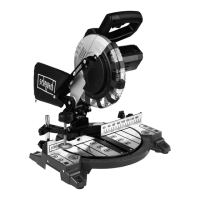
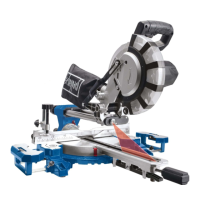
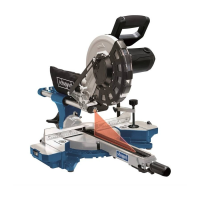
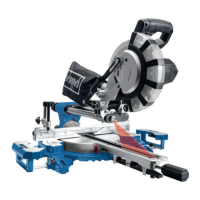
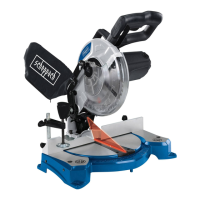
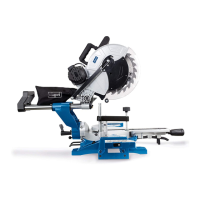
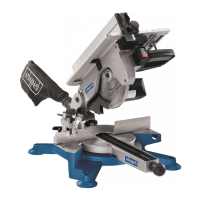
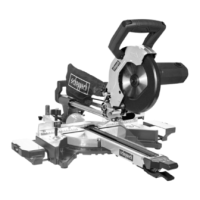
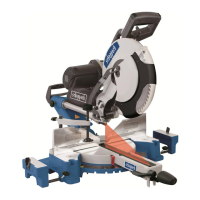
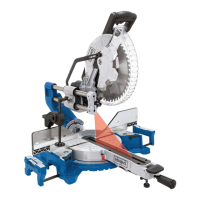
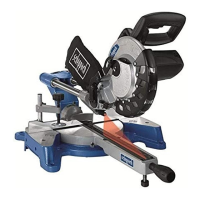
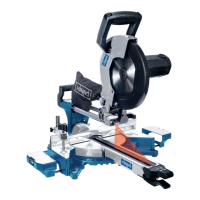
